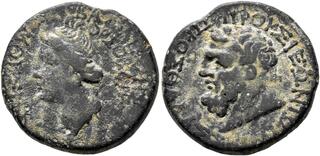This record is provided by CoinArchives, a database of numismatic auction catalogs.
Important copyright information:
The data below is presented by permission of the copyright holder(s). Reproduction is allowed only by authorization from Leu Numismatik AG.
Important copyright information:
The data below is presented by permission of the copyright holder(s). Reproduction is allowed only by authorization from Leu Numismatik AG.
| Leu Numismatik AG > Web Auction 18 | Auction date: 18 December 2021 |
| Lot number: 1033 | |
| Lot description: BITHYNIA. Kios (as Prusias ad Mare). Orsobaris Musa, daughter of Mithradates VI Eupator, circa mid to late 1st century BC. Tetrachalkon (Bronze, 23 mm, 7.56 g, 12 h), circa 30-22 BC (?). BAΣIΛIΣΣHΣ - OPΣOBAPIOΣ / MOYΣHΣ Diademed head of Orsobaris Musa to left. Rev. ΠPOYΣIEΩN TΩN / ΠPOΣ ΘAΛAΣΣHI Bearded head of Herakles to left. RPC I 2020. Extremely rare. Some deposits, otherwise, good fine. The dates of Orsobaris Musa's birth and death are unclear, but Appian reports that she was a daughter of Mithradates VI of Pontos and brought to Rome in 61 BC, together with a number of other descendants of the Pontic king, to be presented in Pompey's great triumph (App. Mithr. 117). We also know that Orsobaris married Lykomedes of Comana, an unsuccessful contender for the Bithynian throne in 74 BC and priest-king of the temple-state of Comana in 47-30 BC, at an uncertain time in her life. The chronology is further complicated by the present coin type struck in the Bithynian city of Prusias ad Mare, presenting her name as 'Queen Orsobaris Musa', and another issue struck in the same mint for 'Orodaltis, daughter of Lykomedes' (RPC 2021). It seems apparent that Orodaltis was the daughter of Lykomedes and Orsobaris and that she lived in the city of Prusias ad Mare at some point in the late 1st century BC (possibly before, or until, the administrative reforms of Agrippa in Asia Minor in 22 BC). Yet, if that is the case, when did her mother, being married to Lykomedes and likely living in Comana in 47-30 BC, rule the city? A likely assumption is that Orsobaris received the city of Prusias ad Mare as a principality from Augustus after the death of her husband in 30 BC, and therefore to see the types in her and her daughter's name as part of a single issue, produced at some point in the years thereafter. This reconstruction explains the striking stylistic similarities between the coinage for Orsobaris and for her daughter, most apparent in the rendering of the portraits and the curious placement of the legends, both of which indicate the hand of a single artist. Orsobaris, as the senior ruler, would thus have issued a larger denomination, naming herself 'queen' and associating herself with the founder of Kios-Prusias, Herakles, on the reverse, while her daughter, on the smaller half denomination, appears without any title and is only called the 'daughter of Lykomedes'. Starting price: 50 CHF |  |


